

Features of Learn Japanese Online: Elementary
 |
すべてをオンラインの一箇所に統合 / All in One Online Package |
 |
LJOは教科書本体、ワークブック、オーディオプログラム、ビデオプログラム、ウェブコンテンツをすべて一つのパッケージとして統合しインターネット上で提供します。従来の教科書ではこれらが散在していたため使い勝手に問題がありました。例えばダイアログビデオを例に取ってみましょう。ダイアログビデオが存在するとしても、それはDVDや教科書HPで提供されてきました。ディスクを操作したりHPで視聴したいビデオを探すには手間がかかります。LJOではダイアログはユニットの紹介ページに貼り付けられていますので、クリックするだけですぐ再生ができます。 LJOはPDFファイルをインターネットに載せたものではありませんし、単なるウェブページの寄せ集めでもありません。インターアクティブな機能をふんだんに搭載したウェブアプリケーションなのです。 LJO integrates main text, workbook, audio and video programs, and web contents into one online package. Traditionally, these pieces are provided separately, making it difficult to use. Take, for instance, a dialog video. If dialog videos are included in a textbook package, they are provided on a disk or at a textbook website. Handling a disk or having to log into a website and navigate to the video you want to watch takes effort. In LJO, dialog videos are right on the unit introduction page waiting to be clicked and played immediately. LJO is not a PDF document placed online or a mere series of webpages; it is a full-fledged web application with lots of interactive features. |
 |
教科書の全体像 / Overall Structure |
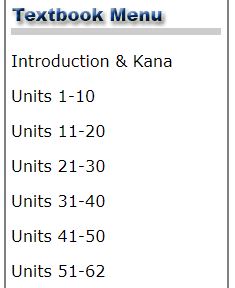 |
LJOは、平仮名、カタカナのユニットおよびダイアログをベースとした62のユニットを合わせた64のユニットで構成されています。Unit 1から30がBook 1、Unit 31から62がBook 2と分かれていますが、アクセスの利便性を考慮して連続的にアクセスできるようになっています。全体でいわゆる「初級文法」の内容をカバーします。 典型的なユニットは、ダイアログビデオ、単語・表現紹介、漢字紹介/練習、文法解説ビデオおよび文章による文法解説、話す練習、聞く練習、読む練習、書く練習、アクティビティー、文化紹介、ユニットの総括評価となるパフォーマンステストで構成されています。 LJO consists of 64 units altogher, consisting of Hiragana & Katakana units and 62 dialog-based units. Units 1-30 constitute Book 1, and Units 31-62 Book 2, although the two books are seamlessly connected for ease of access. The two books together cover 初級文法, what is generally considered introductory-level grammar. A typical unit consists of dialog videos, new words/expressions, kanji presentation/practice, grammar explanations accompanied by grammar lecture videos, speaking practice, listening exercises, reading exercises, writing practice, classroom activities, culture presentation, and summative assessment called "Performance Test". |
 |
AI搭載 / AI-Powered |
 |
LJOでは教師の負担を軽減し、学生に即時フィードバックを提供するべく、AIを搭載しています。特に採点・フィードバックに手間がかかる口頭練習の大部分がAI搭載で自動採点されます。 LJO incorporates AI to reduce the burden on teachers and provide immediate feedback to students. Specifically, most of the oral practice, which requires significant effort for grading and feedback, is automatically graded by AI. |
 |
スモールステップ / Small Steps |
 |
各ユニットで紹介する文法項目は通常二つのみに制限されていて、軽量で消化しやすいものとなっています。このため、着実な上達が見込めます。 Each unit is light weight and digestible, presenting typically two grammar points only. This encourages steady progress. |
 |
ダイアログ中心の構成 / Dialog-centered |
 |
各ユニットは、一つまたは複数のダイアログを動画で提示することから始まり、それを中心に練習が構成されています。ダイアログはまずビデオとして提示されるべきであり、スクリプトはその後に補足するものであると考えます。 Each unit begins with one or more dialogs presented as videos, around which the exercises are origanized. We firmly believe that dialogs should be presented as videos first, and scripts can follow as a supplement. |
 |
音声付き単語リスト / Enhanced Vocabulary List |
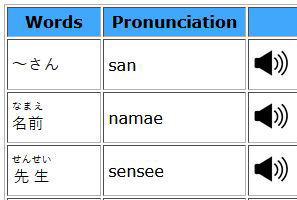 |
単語紹介ページでは、各単語に音声リンクが付いているのでワンクリックで発音のしかたを確認することができます。またBookごとに検索可能な全単語リストも装備されています。 On the vocabulary introduction page, each word has an audio link so students can check how to pronounce it with just one click. Also, a full searchable word list is included for each book. |
 |
ビデオ付き漢字ページ / Enhanced Kanji Presentation |
漢字ページでは、Book 1で202字、Book 2で226字、全体で428字の漢字が紹介されます。AP漢字はすべてカバーします。各漢字に実際にネイティブが書いているところをキャプチャしたビデオが用意されています。 428 kanji are presented, with Book 1 covering 202 and Book 2 226. All AP Kanji are covered. Each kanji character presentation includes a video demonstrating actual handwriting. |
||
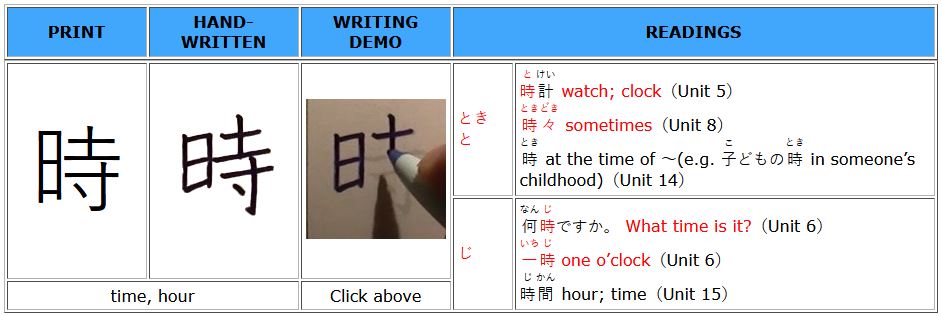 |
||
 |
文法学習支援 / Support for Grammar Learning |
文法ページは、文章による文法解説に加え、同内容の文法解説ビデオを標準で装備しています。ビデオにはわかりやすくするために工夫したアニメーションがふんだんに用いられており、教師のレクチャーでなく、フレンドリーなチューターを思わせるナレーションが流れます。また自動採点の文法クイズにより理解度を自己診断することができます。 In addition to the written grammar explanations, the grammar page comes standard with a grammar explanation video of the same content. The videos are richly animated to make them easy to understand, and the narration reminds you of a friendly tutor rather than a teacher lecturing. Also, students can self-diagnose their level of understanding with computer-graded grammar quizzes. |
||
A grammar video 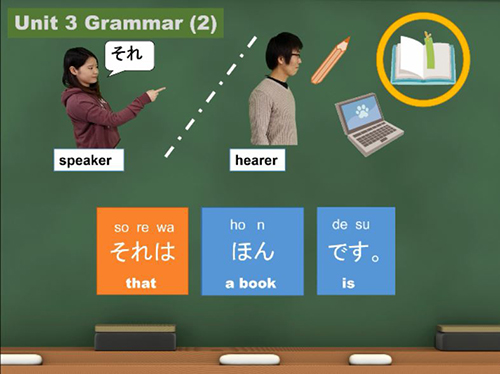 |
||
A grammar quiz 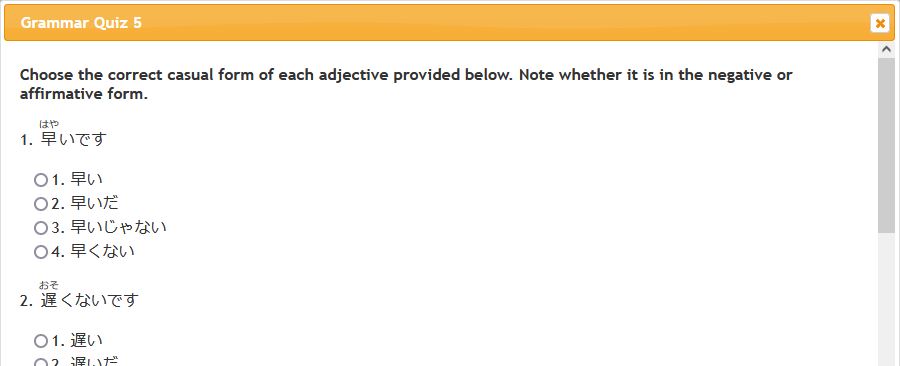 |
||
 |
口頭能力育成を重視 / Emphasis on Oral Proficiency Development |
反転授業は、単に文法解説ビデオを見せるだけではありません。学生が対面セッションの準備のためにできることはもっとたくさんあります。個人の基礎口頭練習はその良い例です。LJOには非同期の口頭練習が装備されています。提出された音声の採点には時間がかかるのではないかと不安に思われるかもしれませんが、口頭練習の大半は搭載されているAIにより自動採点されます。自動採点でないものの多くは、キューに基づいて発話を録音し、その後でモデルを聴いてどうだったか自己チェックするという「Say and Check」形式を採っています。後日、教師は学生の提出した音声を聴いて採点したり、フィードバックをしたりすることができます。 Flipped classroom is not just about showing grammar videos; there is a lot more that students can do to prepare for in-person sessions. Individual basic oral practice is one good example. LJO provides extensive asynchronous oral practice. We know from experience that grading oral submissions is time-consuming. For this reason, a majority of oral exercises are AI-graded. Those that aren't AI-graded are mostly in what we call "say and check" format. In this format, students are prompted to produce and record an utterance, and then listen to the model to self-check how they did. Later, instructors can review students' audio submissions to grade them and give feedback on them. |
||
 |
||
 |
総括的口頭評価 / Summative Oral Assessments |
LJOにはユニットテストとして口頭パフォーマンステストが準備されています。これにより口頭能力の発達を継続的に評価することが可能です。このパフォーマンステストは宮本・深田 (2019)で提唱されている、数年にわたる現場実践を経て確立したデザインを採用しています。 Oral Performance Assessments are provided as a unit test. This makes it possible to continuously assess students' oral proficiency development. These assessments follow the design presented by Miyamoto & Fukada (2019), which has been field tested for several years. Miyamoto, M. & A. Fukada (2019), 継続的オーラルアセスメントの開発ー「話せる」を実感する評価法を目指して― (Development of continuous oral assessment: towards a method that captures “can speak”). Lee Jae-ho (ed.) ICT×日本語教育 (ICT × Japanese Language Teaching), Tokyo: Hitsuji Publishing Inc., 192-204. |
||
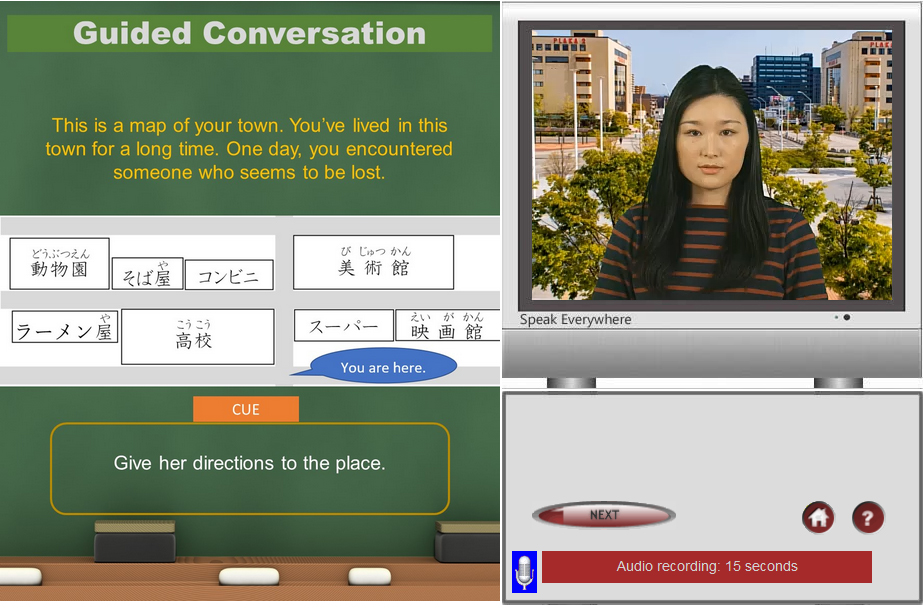 |
||
 |
聴解・読解練習 / Listening and Reading Practice |
LJOの聴解・読解練習は自動採点方式になっていますので、学生が自習時間に一人で取り組むことができます。これにより反転授業の自宅学習でできることの幅が広がります。 LJO's listening and reading comprehension exercises are computer-graded so that students can work on them alone during their self-study time. This expands the range of things that can be done in the flipped classroom home study. |
||
 |
||
 |
教師用システム / Instructor System |
ここまでは学生システムについて述べてきましたが、教師の教授活動を支援する教師用システムも完備しています。ここでは、練習を課したり(Figure 1)、成績を管理したり(Figure 2)、学生の提出したものを採点したり(Figure 3)することができます。 So far, we have been discussing the student system, but we also have an instructor system to support instructors in their instructional activities. Here, an instructor can assign exercises (Figure 1), manage grades (Figure 2), and grade student submissions (Figure 3). |
||
Figure 1: Exercise Assignment Control  |
||
Figure 2: Grade Management Screen 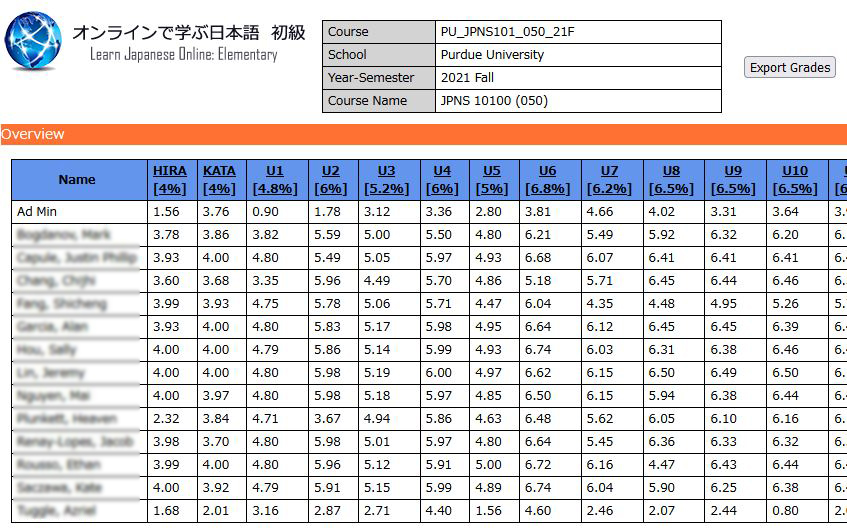 |
||
Figure 3: Grading Screen 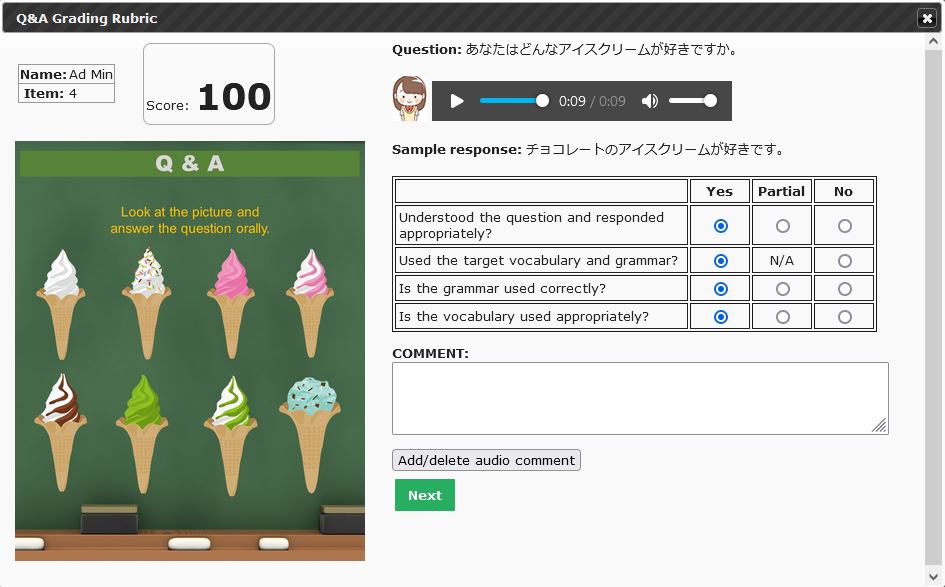 |
||